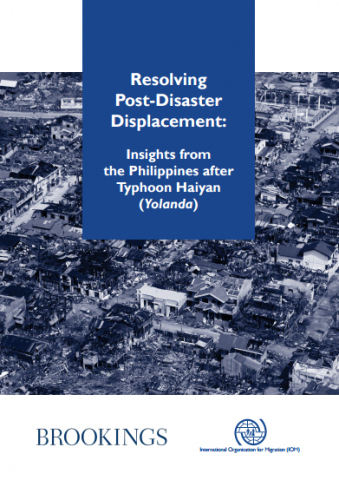Resolving Post-Disaster Displacement: Insights from the Philippines after Typhoon Haiyan (Yolanda)


Drawing on the rights-based approach laid out in the Inter-Agency Standing Committee Framework on Durable Solutions for Internally Displaced Persons (IASC Framework) and reflected in many of the Philippines’ own domestic standards, this report analyses efforts to resolve the displacement crisis generated by Typhoon Haiyan.
According to the IASC Framework, durable solutions (whether return, local integration, or sustainable settlement/relocation elsewhere) have been reached when IDPs “no longer have any specific assistance and protection needs that are linked to their displacement and can enjoy their human rights without discrimination on account of their displacement.” The Framework examines the process for achieving durable solutions, emphasizing that IDPs have the right to actively participate in planning and decision-making related to the resolution of displacement, and to make voluntary, informed choices on durable solutions. The Framework also lays out key criteria that help determine the extent to which durable solutions have been achieved. These criteria include the ability of IDPs to enjoy without discrimination: long-term safety and security; an adequate standard of living; access to employment and livelihoods; and access to effective mechanisms to restore their housing, land and property.
Drawing on the results of a survey of over 4,500 Haiyan-affected households, focus groups with community members, site visits, and interviews with government officials, donors, and the staff of non-governmental organizations (NGO) and international organizations, the study examines the extent to which these criteria have been realized. It explores obstacles to the pursuit of durable solutions, and makes recommendations to help address these challenges. It also identifies insights from experiences in the Philippines that may help inform the achievement of durable solutions in other post-disaster contexts.
Brookings Institution, the; International Organization for Migration (IOM), 2015
http://www.brookings.edu/~/media/Research/Files/Reports/2015/06/15-philippines-t…
http://www.brookings.edu/~/media/Research/Files/Reports/2015/06/15-philippines-typhoon-haiyan-displacement-solutions/Resolving-PostDisaster-DisplacementInsights-from-the-Philippines-after-Typhoon-Haiyan-June-2015.pdf?la=en
